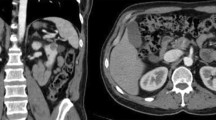Abstract
Objective
Fibroepithelial polyps (FEPs) are the most common benign lesions of the ureter. However, FEPs of the ureter accompanied by calculi are rare. In this study, we reviewed our experiences with five children having FEP associated with ureteral calculi to define more clearly this entity and its outcome following observation.
Materials and Methods
We identified five children who were intraoperatively found to have FEP associated with ureteral calculi during the period 2000–2008.
Results
The patients included four males and one female, and the average age of these patients was 6.4 years (range 4–9). The main symptoms were flank pain (five patients), hematuria (four patients), and dysuria (two patients). Radiographically, all patients showed complete ureteral obstruction due to distal ureter stone and hydronephrosis. Fibroepithelial polyps and stones were located left distal ureter in all children. These polyps were 1–2 cm, with a mean size of 1.5 cm. Stone sizes ranged from 5 to 13 mm (mean 8.8 mm). The stones were smashed into smaller fragments using a pneumatic lithotriptor, and the pieces were removed with forceps. After the lithotripsy, the polyps were grasped with biopsy forceps and punch biopsies were done. FEPs were diagnosed in all cases by postoperative histological examination. During the follow-up period of these patients, none of the FEPs displayed any growth or symptom.
Conclusions
Due to the potential complications during the ureteroscopic resection, our opinion is to observe the small FEPs without joint symptoms and hydronephrosis.




Similar content being viewed by others
References
Adey GS, Vargas SO, Retik AB et al (2003) Fibroepithelial polyps causing ureteropelvic junction obstruction in children. J Urol 169(5):1834–1836. doi:10.1097/01.ju.0000061966.21966.94
Wang ZJ, Meng MV (2008) Ureteral fibroepithelial polyp. J Ultrasound Med 27:1647–1649
Yeh CC, Lin HC, Chen CC et al (2001) Ureteral fibroepithelial polyp prolapsed into the bladder cavity suspending a bladder stone. J Urol 165(5):1627–1628. doi:10.1016/S0022-5347(05)66368-9
Williams TR, Wagner BJ, Corse WR et al (2002) Fibroepithelial polyps of the urinary tract. Abdom Imaging 27:217–221. doi:10.1007/s00261-001-0066-z
Lam JS, Bingham JB, Gupta M (2003) Endoscopic treatment of fibroepithelial polyps of the renal pelvis and ureter. Urology 62(5):810–813. doi:10.1016/S0090-4295(03)00691-5
Turunc T, Kuzgunbay B, Canpolat T (2008) Ureteral fibroepithelial polyps with calculi: a case series. J Med Case Reports 2:280. doi:10.1186/1752-1947-2-280
Niu ZB, Yang Y, Hou Y et al (2007) Ureteral polyps: an etiological factor of hydronephrosis in children that should not be ignored. Pediatr Surg Int 23(4):323–326. doi:10.1007/s00383-007-1884-z
Kumar A, Das KS, Trivedi S et al (2008) Genitourinary polyps: summary of the 10 year experiences of a single institute. Int Urol Nephrol 40:901–907. doi:10.1007/s11255-008-9391-2
Tekdogan UY, Canakli F, Aslan Y et al (2005) Bilateral ureteral fibroepithelial polyps and review of the literature. Int J Urol 12:98–100. doi:10.1111/j.1442-2042.2004.00974.x
Yagi S, Kawano Y, Gotanda T et al (2001) Endoscopic treatment of a long fibroepithelial polyp. Int J Urol 8:467–469. doi:10.1046/j.1442-2042.2001.00343.x
Ugras S, Odabas O, Aydın S et al (1997) Fibroepithelial polyp of the ureter associated with an adjacent ureteral calculus. Int Urol Nephrol 29(5):543–549. doi:10.1007/BF02552199
Baltogiannis D, Kafetzoulis A, Giannakis D et al (2008) Fibroepithelial polyp of distal ureter with periodic prolapse into bladder. Urol Int 80:338–340. doi:10.1159/000127355
Reuter KL, Krolikowski FJ, D’Orsi CJ et al (1982) Inflammatory polyp of the renal pelvis simulating transitional cell carcinoma. Radiology 144:505–506
Kokotas NS, Zissis JM, Kastriotis JB et al (1979) Benign polyps of the ureter. Int Urol Nephrol 11(4):289–294. doi:10.1007/BF02086815
Mydlo J, Reda E, Gill B et al. (1988) Fibroepithelial polyp in a child. Urology 31:318–320. doi:10.1016/0090-4295(88)90089-1
Author information
Authors and Affiliations
Corresponding author
Rights and permissions
About this article
Cite this article
Kara, C., Reşorlu, B., Oğuz, U. et al. Incidentally detected ureteral fibroepithelial polyps in children: is endoscopic treatment of them really necessary?. Int Urol Nephrol 42, 1–5 (2010). https://doi.org/10.1007/s11255-009-9567-4
Received:
Accepted:
Published:
Issue Date:
DOI: https://doi.org/10.1007/s11255-009-9567-4




